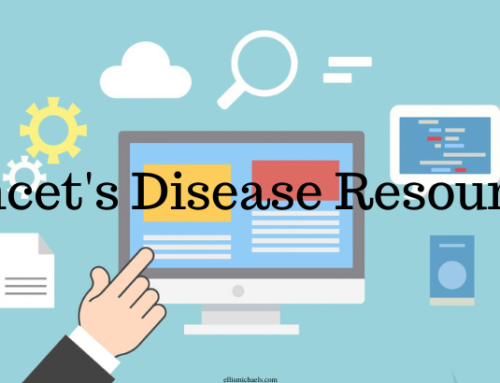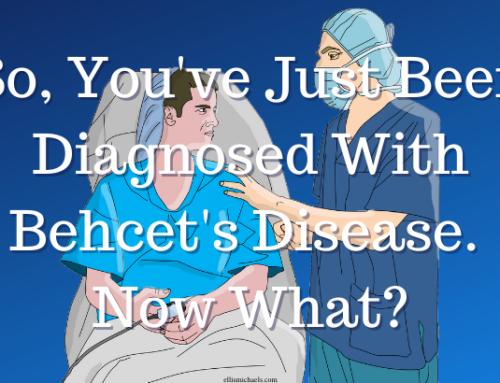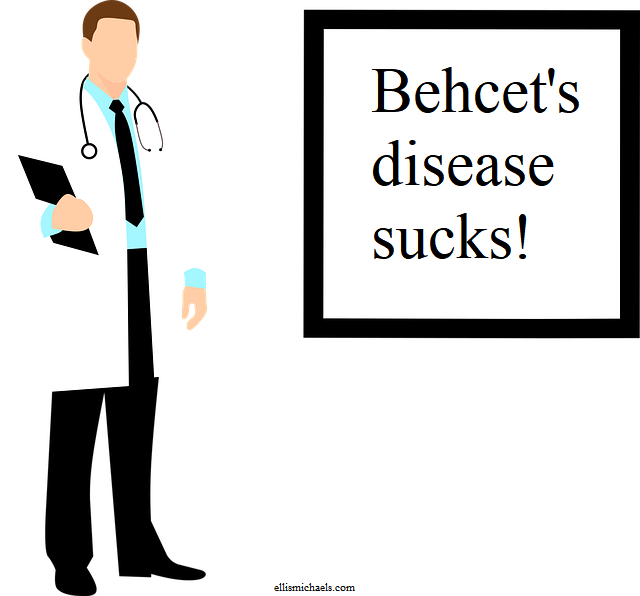If you or someone close to you has recently been diagnosed, you might be wondering what it’s like to have Behcet’s disease. Maybe you work in the healthcare field and are trying to better understand one of your patients. Or maybe you’re just some curious dude or dudette who likes to learn about rare diseases in your spare time.
Well, I’ve got some good news and some bad news. The good news is, I’m going to tell you exactly what it’s like having Behcet’s disease. The bad news, particularly if you or a loved one has been recently diagnosed, is that living with Behcet’s isn’t fun. But there are some silver linings to having the disease which we’ll get to in a little bit.
But first, let me briefly explain what Behcet’s disease is. You may already know a little (or a lot) about it, so I won’t go into too much detail. Besides, this article is about what it’s like having Behcet’s, not what the disease is. But for those of you who don’t know much about Behcet’s, here’s a brief description of the illness.
What Is Behcet’s Disease?
Like Crohn’s, lupus, multiple sclerosis, psoriasis, and dozens of other illnesses, Behcet’s is classified as an autoimmune disease. These are conditions where the immune system mistakenly attacks perfectly healthy cells and tissues. Normally, the immune system’s job is to fight off foreign invaders like viruses and bacteria. But in people with autoimmune diseases, their immune systems go to war with foreign invaders and their own bodies – or at least parts of them.
In people with Behcet’s disease (sometimes called Behcet’s syndrome), the body part the immune system attacks are blood vessels, large and small.1 Behcet’s is a type of vasculitis, which is the medical term for inflamed blood vessels. And it is the only systemic type of vasculitis that can affect both veins and arteries.2
While Behcet’s disease only causes inflammation in blood vessels, guess where blood vessels are? That’s right: everywhere. They’re in your eyes, brain, skin, and everywhere else that needs oxygen, which is pretty much everywhere but your hair. So, basically, Behcet’s can affect any body part. Here are some of the symptoms of Behcet’s disease:3
- Oral and genital ulcers
- Eye inflammation
 Various skin problems
Various skin problems- Muscle & joint pain
- Neurological symptoms
- Blood clots
- Headaches
- Fatigue
- Abdominal pain
That’s just a short list of what Behcet’s has to offer. But that’s not all. In severe cases, it can even kill you. Fortunately, for most people, that’s not the case. In fact, most people with Behcet’s are able to live (mostly) normal, fulfilling lives. But in rare cases it can cause pulmonary embolism, stroke, and aneurysm resulting in death.3 Fortunately, this occurs in less than 5% of people with Behcet’s. And good news, ladies: for the unfortunate few who do die from Behcet’s, the vast majority (6 out of 7) are male.4
Now that we’ve taken a look at what Behcet’s disease is, let me tell you what it’s like having it. Of course, everybody is different. No two people with Behcet’s have the exact same symptoms. But this should give you an idea of what to expect if you or someone you know is diagnosed with it.
What Is It Like Having Behcet’s Disease?
If I was to sum up what it’s like having Behcet’s disease in two words, they would be: it sucks. But like most things in life, the experience of living with a chronic autoimmune disease is too complicated to be summed up in a couple of words. But overall, as I mentioned in the introduction, it’s not fun.

I was diagnosed at the age of 16 but started having symptoms much earlier. It was only when I experienced eye problems that I got referred to a retina specialist who diagnosed me with Behcet’s disease. In the years leading up to my diagnosis, I’d been to a number of specialists for a variety of symptoms. The retina specialist put the pieces of the puzzle together and finally gave me the name of what had been wreaking havoc on my body.
It’s not uncommon for people with Behcet’s to have symptoms for years before being (accurately) diagnosed. Before seeing the retina specialist who made the diagnosis, I’d been to the following doctors for the following reasons:
- Dermatologist – for severe cystic acne, folliculitis, and skin lesions
- Pediatrician – for minor skin problems and referrals to specialists
- Orthopedic surgeon – for severe knee inflammation
- Ophthalmologist – for eye problems and referral to retina specialist
The course that Behcet’s disease takes is different for everyone diagnosed with it. However, there are a few symptoms almost all of us experience. The most common of these are oral and genital ulcers. Oral ulcers affect as many as 99% of people diagnosed with Behcet’s and genital ulcers appear in more than 80% of us.5 For about a decade starting in my teens, I used to get quarter-sized open sores in my mouth an on my balls. Have I mentioned how much fun having Behcet’s disease isn’t?
Behcet's Disease Uncensored (BDU) is a podcast to discuss this rare illness.
Behcet's doesn't censor itself when it attacks our bodies. So why should we censor ourselves when discussing it?
Listen to BDU on Spotify or wherever you listen to podcasts.
You might think that having big, open ulcers on your genitals would be worse than having them in your mouth – but you’d be wrong. Most people with Behcet’s I’ve talked to agree with me that the oral ulcers are worse. For years, it hurt to eat, brush my teeth, and even talk. Now, don’t get me wrong: genital ulcers are no picnic. They hurt like hell, too. But for most people, the oral ulcers are even worse.
 Other skin problems are also very common in people diagnosed with Behcet’s disease and affect up to 99% of us.6 These include papulopustular and acne-like lesions, erythema nodosum, cystic acne, folliculitis, and more. If you don’t know what all of those medical terms mean, that’s okay. All you need to know is that Behcet’s can cause a wide variety of skin problems ranging from little white bumps (folliculitis) to big, golf-ball-sized lumps (cystic acne). I only know what they mean because I’ve experienced them all.
Other skin problems are also very common in people diagnosed with Behcet’s disease and affect up to 99% of us.6 These include papulopustular and acne-like lesions, erythema nodosum, cystic acne, folliculitis, and more. If you don’t know what all of those medical terms mean, that’s okay. All you need to know is that Behcet’s can cause a wide variety of skin problems ranging from little white bumps (folliculitis) to big, golf-ball-sized lumps (cystic acne). I only know what they mean because I’ve experienced them all.
Aside from oral ulcers, genital ulcers, and skin problems, Behcet’s disease also frequently affects the eyes. Up to 72% of people diagnosed with the illness have ocular symptoms.7 I’ve got some more good news for the ladies: eye problems are more common in men than women. For those of us unlucky enough to have ocular involvement, Behcet’s can cause inflammation in different parts of the eye including the iris and, in my case, the retina. In severe cases, it can lead to permanent vision loss. Fortunately, the vast majority of people diagnosed with Behcet’s don’t experience this.8
Those are the most common symptoms of Behcet’s disease. Some people only experience a couple of them while some of us experience all four. For me, the oral ulcers, genital ulcers, and eye inflammation all happened in my teens and early 20’s. I’m 40 now and fortunately haven’t experienced those symptoms in about 15 years. However, I’ve had skin problems off and on since I hit puberty.
Behcet’s also has a number of less-common symptoms. These can include problems with your joints, cardiovascular system, gastrointestinal tract, and nervous system. I’ve experienced symptoms related to most of those at one point or another. But most people don’t. Fortunately, less than half of people with Behcet’s experience cardiovascular problems and less than 10% of people with Behcet’s have neurological involvement.9
Most people diagnosed with Behcet’s are able to lead normal lives. For many, disease symptoms come and go. It often hits hard at first and gradually gets better with time. Some people only experience symptoms for the first few years and then the disease goes into full remission for life.10 Yet others experience blindness, paralysis, and even death. As I’ve said: everyone’s different. But in general, you can live a normal life with Behcet’s.
Mine has been up and down. Behcet’s kicked my butt in my teens and early twenties, went into (more-or-less) full remission in my mid-twenties, then came back full force in my mid-thirties. But despite my diagnosis, I’ve lived an awesome life – and so can most people diagnosed with Behcet’s.

And it hasn’t been all bad. It’s been mostly bad, for sure. But there have been a few silver linings to living with a chronic autoimmune disease. I’ve learned things I’d probably never know otherwise. I’ve grown as a person in ways I definitely wouldn’t have if I was perfectly healthy. And the greatest silver lining of having Behcet’s disease has been the deep, meaningful friendships I’ve made with others who share the diagnosis. Our unique suffering bonds us together in ways healthy people could never understand.
Conclusion
I hope that gives you some idea of what it’s like to have Behcet’s disease. If you or a loved one has been recently diagnosed, with a little luck you’ll be one of the lucky ones who’s symptoms are mild and go away after a couple of years.
If you’d like to learn more about what it’s like having Behcet’s disease in general and my journey in particular, I share every nasty little detail in my book listed below:
Finding Happiness Through Pain and Embarrassment: My Life With Behcet’s Disease – A Memoir
Join the Ellis Michaels mailing list to get notified about new Behcet's disease articles and publications, up-to-date news and info about this rare illness, and more.
References
1Demirturk, O., Tunel, H., & Alemdaroglu, U. (2017). Vascular manifestations of Behcet’s disease. In Gonul, M., & Kartal, S. (Eds.). Behcet’s disease (ch. 9. pp. 149-87). Published online: BoD – Books on Demand.
2Owlia, M., Manshadi, S., & Naderi, N. (2012). Cardiac manifestations of rheumatological conditions: a narrative review. ISRN Rheumatology, published online Oct. 17, 2012: https://www.ncbi.nlm.nih.gov/pmc/articles/PMC3483730/
3Behcet’s disease. (2019, March 7). Mayo Clinic. https://www.mayoclinic.org/diseases-conditions/behcets-disease/symptoms-causes/syc-20351326
3Saadoun, D., Wechsler, B., Desseaux, K, et al. (2010). Mortality in Behcet’s disease. Arthritis & Rheumatism, 62(9):2806-12.
4Park, K., Bang, D., Lee, E., et al. (1993). Clinical study on death in Behcet’s disease. Journal of Korean Medical Science, 8(4):241-5.
5Adil, A., Goyal, A., Bansal, P., et al. (2020, July 4). Behcet’s disease. In: StatPearls. StatPearls Publishing. http://ncbi.nlm.nih.gov/books/NBK470257
6Zeidan, M., Saadoun, D., Garrido, M., et al. (2016). Behcet’s disease pathophysiology: a contemporary review. Autoimmunity Highlights, 7(1):4.
7Zakka, F., Chang, P., Giuliari, G., & Foster, C. (2009). Current trends in the management of ocular symptoms in Adamantiades-Behcet’s disease. Clinical Ophthalmology, 3:567-79.
8Tugal-Tutkun, I., Onal, S., Altan-Yaycioglu, R., et al. (2004). Uveitis in Behcet disease: an analysis of 880 patients. American Journal of Ophthalmology, 138(3):373-80.
9Mendes, D., Correia, M., Barbedo, M., et al. (2009). Behcet’s disease – a contemporary review. Journal of Autoimmunity, 32(3-4):178-88.
10Alibaz-Oner, F., Mumcu, G., Kubilay, Z., et al. (2014). Unmet need in Behcet’s disease: most patients in routine follow-up continue to have oral ulcers. Clinical Rheumatology, 33(12):1773-6.








Leave a Reply